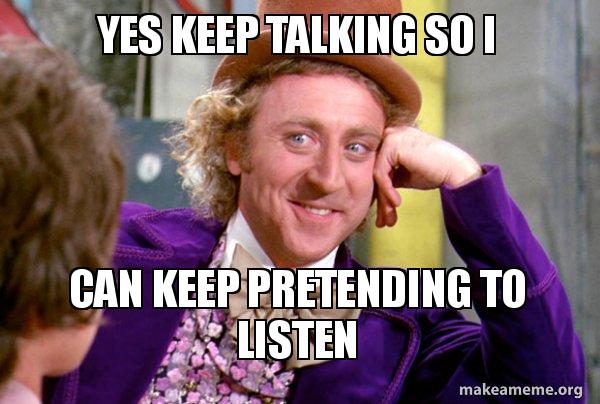
by Robyn Bolton | Oct 11, 2023 | Customer Centricity, Innovation, Leadership
You know that customer insights are important.
You spend time and money to collect customer insights.
But are you using them?
And by “using,” I don’t mean summarizing, synthesizing, discussing, PowerPointing, and presenting the insights. I mean making decisions, changing strategies, and rethinking plans based on them.
I posed this question to a few dozen executives. The awkward silence spoke volumes.
Why do we talk to customers but not listen to them?
In a world of ever more constrained resources, why do we spend our limited time and money collecting insights that we don’t use meaningfully?
It seems wild to have an answer or an insight and not use it, especially if you spent valuable resources getting it. Can you imagine your high school self paying $50 for the answer key to the final in your most challenging class, then crumpling it up, throwing it away, and deciding to just wing the exam?
But this isn’t an exam. This is our job, profession, reputation, and maybe even identity. We have experience and expertise. We are problem solvers.
We have the answers (or believe that we do).
After all, customers can’t tell us what they want. We’re supposed to lead customers to where they should be. Waiting for insights or changing decisions based on what customers think slows us down, and isn’t innovation all about “failing fast,” minimal viable products, and agility?
So, we talk to customers because we know we should.
We use the answers and insights to ensure we have brilliant things to tell the bosses when they ask.
We also miss the opportunity to create something that changes the game.
But it doesn’t have to be this way.
What do you NEED to learn?
It’s easy to rattle off a long list of things you want to learn from customers. You probably also know the things you should learn from customers. But what do you need to learn?
What do you need to know by the end of a conversation so that you can make a decision?
What is the missing piece in the puzzle that, without it, you can’t make progress?
What insight do you need so badly that you won’t end the conversation until you have it?
If the answer is “nothing,” why are you having the conversation?
Will you listen?
Hearing is the “process, function, or power of perceiving a sound,” while listening is “hearing things with thoughtful attention” and a critical first step in making a connection. It’s the difference between talking to Charlie Brown’s teacher and talking to someone you care about deeply. One is noise, the other is meaning.
You may hear everything in a conversation, but if you only listen to what you expect or want to hear, you’ll miss precious insights into situations, motivations, and social dynamics.
If you’re only going to listen to what you want to hear, why are you having the conversation?
Are you willing to be surprised?
We enter conversations to connect with others, and the best way to connect is to agree. Finding common ground is exciting, comforting, and reassuring. It’s great to meet someone from your hometown, who cheers for the same sports team, shares the same hobby, or loves the same restaurant.
When we find ourselves conversing with people who don’t share our beliefs, preferences, or experiences, our survival instincts kick in, and we fight, take flight, or (like my client) freeze.
But here’s the thing – you’re not being attacked by a different opinion. You’re being surprised by it. So, assuming you’re not under actual physical threat, are you willing to lean into the surprise, get curious, ask follow-up questions, and seek to understand it?
If you’re not, why are you having the conversation?
Just because you should doesn’t mean you must.
You know that customer insights are important.
You spend time and money to collect customer insights.
But are you using them to speed the path to product-market fit, establish competitive advantage, and create value?
If you’re not, why are you having the conversation?

by Robyn Bolton | Oct 4, 2023 | Innovation, Leadership, Stories & Examples
“Lego’s Latest Effort to Avoid Oil-Based Plastic Hits Brick Wall” – WSJ
“Lego axes plans to make bricks from recycled bottles” – BBC
“Lego ditches oil-free brick in sustainability setback” – The Financial Times
Last Monday, LEGO found itself doing the Walk of Atonement after announcing to The Financial Times that it was scrapping plans to make bricks from recycled bottles, and media outlets from The Wall Street Journal to Fast Company to WIRED were more than happy to play the Shame Nun.
And it wasn’t just media outlets ringing the Shame Bell:
- “In the future, they should not make these kinds of announcements (prototype made from recyclable plastic) until they actually do it,” Judith Enck, President of Beyond Plastics
- “They are not going to survive as an organization if they don’t find a solution,” Paolo Taticchi, corporate sustainability expert at University College London.
- “Lego undoubtedly had good intentions, but if you’re going to to (sic) announce a major environmental initiative like this—one that affects the core of your company—good intentions aren’t enough. And in this instance, it can even undermine progress.” Jesus Diaz, creative director, screenwriter, and producer at The Magic Sauce, writing forFast Company
As a LEGO lover, I am not unbiased, but WOW, the amount of hypocritical, self-righteous judgment is astounding! All these publications and pundits espouse the need for innovation, yet when a company falls even the tiniest bit short of aspirations, it’s just SHAME (clang) SHAME (clang) SHAME.
In 1946, LEGO founder Ole Kirk Christiansen purchased Denmark’s first plastic injection molding machine. Today, 95% of the company’s 4,400 different bricks are made using acrylonitrile butadiene styrene (ABS), a plastic that requires 4.4 pounds of oil to produce 2.2 pounds of brick. Admittedly, it’s not a great ratio, and it gets worse. The material isn’t biodegradable or easily recyclable, so when the 3% of bricks not handed down to the next generation end up in a landfill, they’ll break down into highly polluting microplastics.
With this context, it’s easy to understand why LEGO’s 2018 announcement that it will move to all non-plastic or recycled materials by 2030 and reduce its carbon emissions by 37% (from 2019’s 1.2 million tons) by 2032 was such big news.
Three years later, in 2021, LEGO announced that its prototype bricks made from polyethylene terephthalate (PET) bottles offered a promising alternative to its oil-based plastic bricks.
But last Monday, after two years of testing, the company shared that what was promising as a prototype isn’t possible at scale because the process required to produce PET-based bricks actually increases carbon emissions.
SHAME!
A LEGO Art World Map (i.e. massive) amount of praise for LEGO
LEGO is doing everything that innovation theorists, consultants, and practitioners recommend:
- Setting a clear vision and measurable goals so that people know what the priorities are (reduce carbon emissions), why they’re important (“playing our part in building a sustainable future and creating a better world for our children to inherit”), and the magnitude of change required
- Defining what is on and off the table in terms of innovation, specifically that they are not willing to compromise the quality, durability, or “clutch power” of bricks to improve sustainability
- Developing a portfolio of bets that includes new materials for products and packaging, new services to keep bricks out of landfills and in kids’ hands, new building and production processes, and active partnerships with suppliers to reduce their climate footprint
- Prototyping and learning before committing to scale because what is possible at a prototype level is different than what’s possible at pilot, which is different from what’s possible at scale.
- Focusing on the big picture and the long-term by not going for the near-term myopic win of declaring “we’re making bricks from more sustainable materials” and instead deciding “not to progress” with something that, when taken as a whole process, moves the company further away from its 2032 goal.
If we want companies to innovate (and we do), shaming them for falling short of perfection is the absolute wrong way to do it.
Is it disappointing that something that seemed promising didn’t work out? Of course. But it’s just one of many avenues and experiments being pursued. This project ended, but the pursuit of the goal hasn’t.
Is 2 years a long time to figure out that you can’t scale a prototype and still meet your goals? Maybe. But, then again, it took P&G 10 years to figure out how to develop and scale a perforation that improved one-handed toilet paper tearing.
Should LEGO have kept all its efforts and success a secret until everything was perfect and ready to launch? Absolutely not. Sharing its goals and priorities, experiments and results, learnings and decisions shows employees, partners, and other companies what it means to innovate and lead.
Is LEGO perfect? No.
Is it trying to be better? Yes.
Isn’t that what we want?

by Robyn Bolton | Aug 30, 2023 | Innovation, Leadership
If you’re like most people, you’ve faced disappointment. Maybe the love of your life didn’t return your affection, you didn’t get into your dream college, or you were passed over for promotion. It hurts. And sometimes, that hurt lingers for a long time.
Until one day, something happens, and you realize your disappointment was a gift. You meet the true love of your life while attending college at your fallback school, and years later, when you get passed over for promotion, the two of you quit your jobs, pursue your dreams, and live happily ever after. Or something like that.
We all experience disappointment. We also all get to choose whether we stay there, lamenting the loss of what coulda shoulda woulda been, or we can persevere, putting one foot in front of the other and playing The Rolling Stones on repeat:
“You can’t always get what you want
But if you try sometimes, well, you might just find
You get what you need”
That’s life.
That’s also innovation.
As innovators, especially leaders of innovators, we rarely get what we want. But we always get what we need (whether we like it or not)
We want to know.
We need to be comfortable not knowing.
Most of us want to know the answer because if we know the answer, there is no risk. There is no chance of being wrong, embarrassed, judged, or punished. But if there is no risk, there is no growth, expansion, or discovery.
Innovation is something new that creates value. If you know everything, you can’t innovate.
As innovators, we need to be comfortable not knowing. When we admit to ourselves that we don’t know something, we open our minds to new information, new perspectives, and new opportunities. When we say we don’t know, we give others permission to be curious, learn, and create.
We want the creative genius and billion-dollar idea.
We need the team and the steady stream of big ideas.
We want to believe that one person blessed with sufficient time, money, and genius can change the world. Some people like to believe they are that person, and most of us think we can hire that person, and when we do find that person and give them the resources they need, they will give us the billion-dollar idea that transforms our company, disrupts the industry, and change the world.
Innovation isn’t magic. Innovation is team work.
We need other people to help us see what we can’t and do what we struggle to do. The idea-person needs the optimizer to bring her idea to life, and the optimizer needs the idea-person so he has a starting point. We need lots of ideas because most won’t work, but we don’t know which ones those are, so we prototype, experiment, assess, and refine our way to the ones that will succeed.
We want to be special.
We need to be equal.
We want to work on the latest and most cutting-edge technology and discuss it using terms that no one outside of Innovation understands. We want our work to be on stage, oohed and aahed over on analyst calls, and talked about with envy and reverence in every meeting. We want to be the cool kids, strutting around our super hip offices in our hoodies and flip-flops or calling into the meeting from Burning Man.
Innovation isn’t about you. It’s about serving others.
As innovators, we create value by solving problems. But we can’t do it alone. We need experienced operators who can quickly spot design flaws and propose modifications. We need accountants and attorneys who instantly see risks and help you navigate around them. We need people to help us bring our ideas to life, but that won’t happen if we act like we’re different or better. Just as we work in service to our customers, we must also work in service to our colleagues by working with them, listening, compromising, and offering help.
What about you?
What do you want?
What are you learning you need?

by Robyn Bolton | Aug 21, 2023 | Innovation, Leadership, Metrics, Tips, Tricks, & Tools
You are a rolling stone, and that means you gather no moss! You read the September issue of HBR (and maybe last week’s article), tossed out your innovation portfolio, and wove yourself an innovation basket to “differentiate the concept from finance and avoid the mistake of treating projects like financial securities, where the goal is usually to maximize returns through diversification [and instead] remember that innovation projects are creative acts.”
Then you explained this to your CFO and received side-eye so devastating it would make Sophie Loren proud.
The reality is that the innovation projects you’re working on are investments, and because they’re risky, diversification is the best way to maximize the returns your company needs.
But it’s not the only way we should communicate, evaluate, and treat them.
Different innovation basket views for different customers
When compiling an innovation basket, the highest priority is having a single source of truth. If people in the organization disagree on what is in and out of the basket, how you measure and manage the portfolio doesn’t matter.
But a single source of truth doesn’t mean you can’t look at that truth from multiple angles.
Having multiple views showing the whole basket while being customized to address each of your internal customer’s Jobs to be Done will turbocharge your ability to get support and resources.
The CFO: What returns will we get and when?
The classic core/adjacent/transformational portfolio is your answer. By examining each project based on where to play (markets and customers) and how to win (offerings, profit models, key resources and activities), you can quickly assess each project’s relative riskiness, potential return, time to ROI, and resource requirements.
The CEO: How does this support and accelerate our strategic priorities?
This is where the new innovation basket is most helpful. By starting with the company’s strategic goals and asking, “What needs to change to achieve our strategy?” leadership teams immediately align innovation goals with corporate strategic priorities. When projects and investments are placed at the intersection of the goal they support, and the mechanism of value creation (e.g., product, process, brand), the CEO can quickly see how investments align with strategic priorities and actively engage in reallocation decisions.
You: Will any of these ever see the light of day?
As much as you hope the answer is “Yes!”, you know the answer is “Some. Maybe. Hopefully.” You also know that the “some” that survive might not be the biggest or the best of the basket. They’ll be the most palatable.
Ignoring that fact won’t make it untrue. Instead, acknowledge it and use it to expand stakeholders’ palates.
Start by articulating your organization’s identity, the answers to “who we are” and “what we do.”
Then place each innovation in one of three buckets based on its fit with the organization’s identity:
- Identity-enhancing innovations that enhance or strengthen the identity
- Identity-stretching innovations that “do not fit with the core of an organization’s identity, but are related enough that if the scope of organizational identity were expanded, the innovation would fit.”
- Identity-challenging innovations that are “in direct conflict with the existing organizational identity.”
It probably won’t surprise you that identity-enhancing innovations are far more likely to receive internal support than identity-challenging innovations. But what may surprise you is that core, adjacent, and transformational innovations can all be identity-enhancing.
For example, Luxxotica and Bausch & Lomb are both in the vision correction industry (eyeglasses and contact lenses, respectively) but have very different identities. Luxxotica views itself as “an eyewear company,” while Bausch & Lomb sees itself as an “eye health company” (apologies for the puns).
When laser-vision correction surgery became widely available, Bausch & Lomb was an early investor because, while the technology would be considered a breakthrough innovation, it was also identity-enhancing. A decade later, Bausch & Lomb’s surgical solutions and ophthalmic pharmaceuticals businesses account for 38% of the company’s revenue and one-third of the growth.
One basket. Multiple Views. All the Answers.
Words are powerful, and using a new one, especially in writing, can change your behavior and brain. But calling a portfolio a basket won’t change the results of your innovation efforts. To do that, you need to understand why you have a basket and look at it in all the ways required to maximize creativity, measure results, and avoid stakeholder side-eye.

by Robyn Bolton | Aug 16, 2023 | Innovation, Leadership, Strategy
You are a savvy manager, so you know that you need an innovation portfolio because (1) a single innovation isn’t enough to generate the magnitude of growth your company needs, and (2) it is the best way to manage inherently risky endeavors and achieve desired returns.
Too bad you’re wrong.
According to an article in the latest issue of HBR, you shouldn’t have an innovation portfolio. You should have an innovation basket.
Once you finish rolling your eyes (goodness knows I did), hear me (and the article’s authors) out because there is a nuanced but important distinction.
Our journey begins with the obvious.
In their article “A New Approach to Strategic Innovation,” authors Haijian Si, Christoph Loch, and Stelios Kavadias argue that portfolio management approaches have become so standardized as to be practically useless, and they propose a new framework for ensuring your innovation activities achieve your strategic goals.
“Companies typically treat their innovation projects as a portfolio: a mix of projects that, collectively, aim to meet their various strategic objectives,” the article begins. “MOO,” I think (household shorthand for Master Of the Obvious).
“When we surveyed 75 companies in China, we discovered that when executives took the trouble to link their project selection to their business’s competitive goals, the contribution of their innovation activities performance increased dramatically,” the authors continue. “Wow, fill this under N for No Sh*t, Sherlock,” responded my internal monologue.
The authors go on to present and explain their new framework, which is interesting in its focus on asking and answering seemingly simple questions (what, who, why, and how) and identifying internal weaknesses and vulnerabilities through a series of iterative and inclusion conversations. The process is a good one but feels more like an augmentation of an existing approach rather than a radically new one.
Then we hit the “portfolio” vs. “basket” moment.
According to the authors, once the management team completes the first step by reaching a consensus on the changes needed to their strategy, they move on to the second step – creating the innovation basket.
The process of categorizing innovation projects is the next step, and it is where our process deviates from established frameworks. We use the word “basket” rather than “portfolio” to denote a company’s collection of innovation projects. In this way, we differentiate the concept from finance and avoid the mistake of treating projects like financial securities, where the goal is usually to maximize returns through diversification. It’s important to remember that innovation projects are creative acts, whereas investment in financial securities is simply the purchase of assets that have already been created.
“Avoid the mistake of treating projects like financial securities” and “remember that innovation projects are creative acts.” Whoa.
Why this is important in a practical sense (and isn’t just academic fun-with-words)
Think about all the advice you’ve read and heard (and that I’ve probably given you) about innovation portfolios – you need a mix of incremental, adjacent, and radical innovations, and, if you’re creating a portfolio from scratch, use the Golden Ratio.
Yes, and this assumes that everything in your innovation portfolio supports your overall strategy, and that the portfolio is reviewed regularly to ensure that the right projects receive the right investments at the right times.
These assumptions are rarely true.
Projects tend to enter the portfolio because a senior executive suggested them or emerged from an innovation event or customer research and feedback. Once in the portfolio, they progress through the funnel until they either launch or are killed because of poor test results or a slashed innovation budget.
They rarely enter the portfolio because they are required to deliver a higher-level strategy, and they rarely exit because they are no longer strategically relevant. Why? Because the innovation projects in your portfolio are “assets that have already been created.”
What this means for you (and why it’s scary)
Swapping “basket” in for “portfolio” isn’t just the choice of a new word to bolster the claim of creating a new approach. It’s a complete reframing of your role as an innovation executive.
You no longer monitor assets that reflect purchases or investments promising yet-to-be-determined payouts. You are actively starting, shifting, and shutting down opportunities based on business strategy and needs. Shifting from a “portfolio” to a basket” turns your role as an executive from someone who monitors performance to someone who actively manages opportunities.
And this should scare you.
Because this makes the challenge of balancing operations and innovation an unavoidable and regular endeavor. Gone are the days of “set it and forget it” innovation management, which often buys innovation teams time to produce results before their resources are noticed and reallocated to core operations.
If you aren’t careful about building and vigorously defending your innovation basket, it will be easy to pluck resources from it and allocate them to the more urgent and “safer” current business needs that also contribute to the strategic changes identified.
Leaving you with an innovation portfolio.

by Robyn Bolton | Aug 9, 2023 | Innovation, Leadership, Strategy, Tips, Tricks, & Tools
It’s that time of year. The summer sun is beating down harder than ever. The grass is fading from green to brown, and no amount of watering seems to be enough. School supply lists hit your Inbox as Back to School sales fill your mailbox.
Yep, it’s almost Strategic Planning & Budgeting season.
You’ve been through this before, so you know what a strategy is (a set of choices and actions to get you closer to your long-term goals). You know why you need one (set common goals, create shared understanding and responsibility, align key stakeholders, inform priorities and decisions, enable your team to be proactive).
But do you know how to create a strategy that gets used?
No, I’m not talking about a process (though that is important). I’m talking about the experience you create and the expectations you maintain for your team as you develop the strategy.
Earlier this week, a client and I talked about this. We were preparing for a strategic planning offsite, one that we vowed would be different from previous strategic planning efforts that were somewhat successful (a new idea was launched and has since become an essential part of the organization) but left the team with lingering frustration about the process and skepticism about this one.
As we shared our thoughts and I scribbled notes, themes emerged. The next day after the themes were presented to the nearly 50 people in attendance, the head of the group raised his hand. “You’ve just described the I Love Lucy approach to strategy.”
Now, I love a good pop culture reference, especially one that requires a bit of history. But I did not get this one. As I scrunched my face in confusion, he explained, “It’s Ay yi yi yi yi!”
And thus, the I Love Lucy approach to strategy was born.
If you want to create a successful strategy, one that gets you closer to your long-term goals despite an uncertain and changing environment, how you create it must be:
Inclusive: Use the IKEA effect to your advantage and give everyone in your organization a voice. Different voices bring different perspectives to the process and help you avoid groupthink. Research from BCG indicates that “organizations that engage a broad group of internal and external stakeholders in their strategy development efforts yield better results than organizations that leave strategy in the hands of a small, central team.”
Illuminating: In the same way, it’s easy to ignore the softball-sized dust bunny under the bed until your mom comes to visit, it’s easy to ignore the parts of the business that aren’t broke but aren’t in an ideal state until strategic planning season. Your process needs to shine a light on all the nooks and crannies of your business, revealing all the opportunities and flaws to be addressed.
Innovative: You would never write a strategic plan that makes your business worse, but are you writing one that makes it better? In most cases, and often for very sensible reasons tied to incentives and metrics, teams write strategic plans for steady and safe growth. But there’s no such thing in unsteady and uncertain times. If you’re not thinking about what’s possible, you’re not planning to achieve your long-term objectives.
Internalized: A common entertainment trope is a villain who monologues for so long that the hero can escape. So you know who else monologues? Managers talking about strategy. And yes, everyone is looking to escape. Don’t be the villain, be the hero and create a strategy everyone can remember and repeat.
Implemented: The most useful strategic plan I ever saw was in a binder being used to straighten a wobbly table. It was useful, but not in the way its creators intended. If no one acts on your strategy, you just made a great table leveler.
Bonus Recommendations
For best results, I also recommend chocolate during the process and Vitameatavegamin after (or during but outside of work hours)
What are your recommendations for a good strategy development experience, a successful strategy, or an I Love Lucy marathon? Let me know in the comments below.





